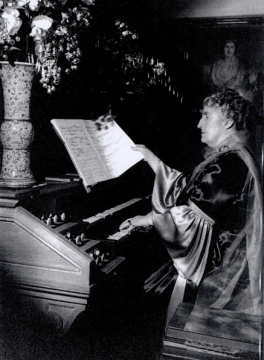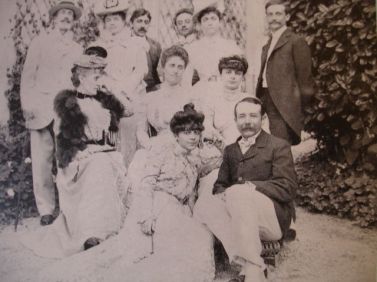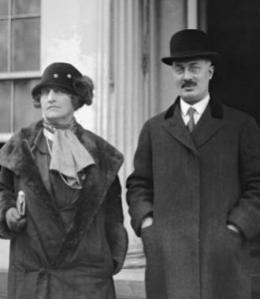Winnaretta Singer was an American woman, daughter of Isaac Singer (the inventor of the first mass-produced sewing machine) and Parisian-born model Isabella Boyer.
Born in 1865, Winnaretta grew up in a family sensitive to the arts, and showed a very strong passion for music since her teenage years. When she turned 13, as a birthday ‘surprise’, she asked to hear a performance of her favourite work by Beethoven, the String Quartet op. 131, which was still considered to be an ‘incomprehensible’ piece of music by the old-fashioned Parisian musical world of the time (Kahan, 2009, p.22). Many years later, after an emotional first meeting with Virginia Woolf,Winnaretta wrote to her:
Dear Mrs Woolf,
(When will you allow me to call you Virginia, and when will you call me Winnaretta?)
It wasn’t the wonderful Cavatina, but the beginning of the XIVth quartet, Opus 131 that I longed to hear on my 13th birthday. I must have also sent you that record, with the Opus 130. Anyhow here are the opening bars – they have always been one of the greatest comforts of my life, together with the Prelude of the 23rd fugue in Bach’s 48. Alas! I can’t write it myself, but I will try to dictate all I can remember about my 13th birthday, as you are good enough to care what happened on that particular birthday – which touches me deeply.
(…) I shall never forget that hour with you by the fire – it is locked away in my heart forever.
Yrs gratefully and affectionately
Winnaretta (de Polignac) (as cited in Kahan, 2009, p.345)
At the age of 15 Winnaretta met the composer Gabriel Fauré and they began a life-
long relationship based on friendship, trust and mutual admiration. As reported in Kahan’s book, ‘Faurè, recognizing Winnaretta’s intelligence and artistic sensibilities, may have had feelings for her similar to those of Schumann for the young Clara Wieck before the blossoming of their romance. As for her, the dashing, ardent composer was the young woman’s first musical mentor, and an important friend’ (Kahan, 2009, p.23).
From a young age, Winnaretta showed interest in both French and foreign contemporary music. In 1882, she visited the Bayreuth Festival for the first time and became such a passionate admirer of Wagner’s music that she decided to visit the town once a year from then on. Her attitude towards contemporary German music was all the more astonishing if we consider that, at the time, Wagner’s music was unwelcomed in most of Paris’ concert halls and theatres, mostly due to widespread anti-German feelings following France’s defeat in the Franco-Prussian War (Fauser, 2009, p.349).
Not only was she forward-looking in terms of contemporary classical music, Winnaretta was also a fine painter and a real admirer of the works of her contemporaries, in particular Edgar Degas and Claude Manet. She recalls in her memoirs: ‘Although I secretly loved music most, painting attracted me almost equally, and I spent all the time possible at the Musée du Louvre, without understanding much of what I saw there, but forming the strongest likes and dislikes’ (Polignac, 1945, p.112). In 1885, Winnaretta painted a portrait of her sister Belle-Blanche which was admitted at the 1886 Paris Salon and offered a place in the exhibition.
Isaac Singer died on 24 July 1875, leaving Winnaretta approximately $900,000: as soon as she turned 21, she quickly organised for all her wealth to be put in her name and to become the legal administrator of her inheritance (Kahan, 2009, p.27). From then on, Winnaretta chose to invest her fortune in that activity which most made her happy and satisfied: sponsoring the arts, especially music.
In order to obtain financial and social independence from her family, Winnaretta married Prince Louis de Scey-Montbéliard in 1877 but this unhappy marriage was to end a few years later because of Winnaretta’s homosexual inclinations. However, Winnaretta had clear ambitions regarding her place in the Parisian society of the time, and she soon realised she couldn’t hope to achieve anything if she was to remain an unmarried woman. Thanks to unpredictable circumstances, the perfect solution to Winnaretta’s problems appeared in the person of the Prince Edmond de Polignac. Descendent of an old aristocratic family, having lost all his fortune in the stock market, Edmond was a sensitive and introvert man, whose only life ambition was to become a composer. The couple seemed to fit together perfectly: he was penniless but had an important title; she was extremely rich but needed a connection with the Parisian aristocracy in order to be accepted in its circles. Moreover, they were both homosexuals.
Winnaretta and Edmond lived happily together until his death in 1901, united by the common passion of music and by the desire to be surrounded by the emerging composers and performers of the time. ‘Now, with Edmond at her side, Winnaretta began her second career as an aristocratic musical hostess in Paris. (…) Winnaretta decided to “open” her atelier in early 1894 (…). By day, the newly renovated atelier was Winnaretta’s painting studio; by night it became a recital hall’ (Kahan, 2009, p.85). With Edmond’s collaboration, Winnaretta was able to establish a very successful salon in their palace on Rue Cartambert in Paris, which attracted some of the most prominent members of the French aristocracy, and most importantly, it became a place for French and foreign composers to promote their newly-composed music. Being a pianist and organist herself, she had enough musical knowledge to be able to recognise a composer’s talent early on in her or his career. She became known for her refined musical taste and for her understanding of repertoire still unknown in Paris at the time: from the early music of Bach, Handel and Rameau to complex Modernist avant garde music.
 Winnaretta’s Parisian salon was attended by most of her contemporary musicians such as Gabriel Fauré, Igor Stravinsky, Claude Debussy, Eugène Ysaÿe, George Enescu, Jean Francaix, Sergei Prokofiev, Maurice Ravel, Manuel De Falla, Jules Massenet, Joseph Suk, Clara Haskil, Arthur Rubinstein, Dinu Lipatti and Nadia Boulanger. Beyond the sphere of classical music, Winnaretta’s salon was known and frequented by poets and writers of the time, notably Marcel Proust, Jean Cocteau, Paul Verlaine and Colette.
Winnaretta’s Parisian salon was attended by most of her contemporary musicians such as Gabriel Fauré, Igor Stravinsky, Claude Debussy, Eugène Ysaÿe, George Enescu, Jean Francaix, Sergei Prokofiev, Maurice Ravel, Manuel De Falla, Jules Massenet, Joseph Suk, Clara Haskil, Arthur Rubinstein, Dinu Lipatti and Nadia Boulanger. Beyond the sphere of classical music, Winnaretta’s salon was known and frequented by poets and writers of the time, notably Marcel Proust, Jean Cocteau, Paul Verlaine and Colette.

Proust and friends. Winnaretta is sitting in the middle of the picture, Proust appears at the back, third person from the left


